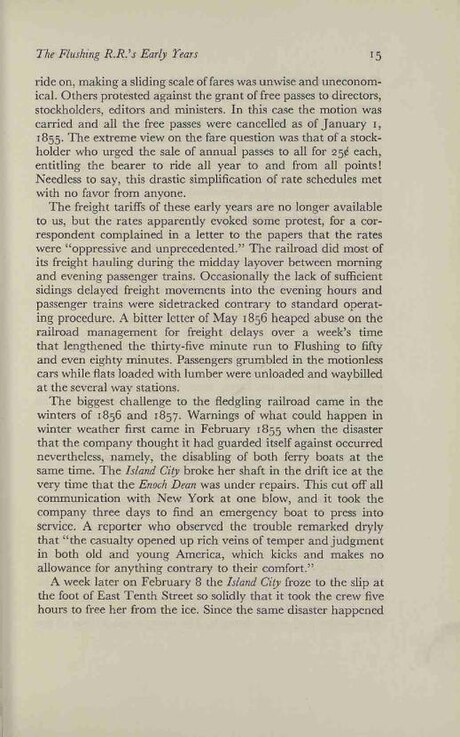ride on, making a sliding scale of fares was unwise and uneconomical. Others protested against the grant of free passes to directors, stockholders, editors and ministers. In this case the motion was carried and all the free passes were cancelled as of January 1, 1855. The extreme view on the fare question was that of a stockholder who urged the sale of annual passes to all for 25¢ each, entitling the bearer to ride all year to and from all points! Needless to say, this drastic simplification of rate schedules met with no favor from anyone.
The freight tariffs of these early years are no longer available to us, but the rates apparently evoked some protest, for a correspondent complained in a letter to the papers that the rates were "oppressive and unprecedented." The railroad did most of its freight hauling during the midday layover between morning and evening passenger trains. Occasionally the lack of sufficient sidings delayed freight movements into the evening hours and passenger trains were sidetracked contrary to standard operating procedure. A bitter letter of May 1856 heaped abuse on the railroad management for freight delays over a week's time that lengthened the thirty-five minute run to Flushing to fifty and even eighty minutes. Passengers grumbled in the motionless cars while flats loaded with lumber were unloaded and waybilled at the several way stations.
The biggest challenge to the fledgling railroad came in the winters of 1856 and 1857. Warnings of what could happen in winter weather first came in February 1855 when the disaster that the company thought it had guarded itself against occurred nevertheless, namely, the disabling of both ferry boats at the same time. The Island City broke her shaft in the drift ice at the very time that the Enoch Dean was under repairs. This cut off all communication with New York at one blow, and it took the company three days to find an emergency boat to press into service. A reporter who observed the trouble remarked dryly that "the casualty opened up rich veins of temper and judgment in both old and young America, which kicks and makes no allowance for anything contrary to their comfort."
A week later on February 8 the Island City froze to the slip at the foot of East Tenth Street so solidly that it took the crew five hours to free her from the ice. Since the same disaster happened
